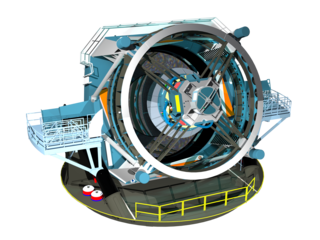 W
WThe Extremely Large Telescope (ELT) is an astronomical observatory currently under construction. When completed, it is planned to be the world's largest optical/near-infrared extremely large telescope. Part of the European Southern Observatory (ESO) agency, it is located on top of Cerro Armazones in the Atacama Desert of northern Chile. The design consists of a reflecting telescope with a 39.3-metre-diameter (130-foot) segmented primary mirror and a 4.2 m (14 ft) diameter secondary mirror, and will be supported by adaptive optics, eight laser guide star units and multiple large science instruments. The observatory aims to gather 100 million times more light than the human eye, 13 times more light than the largest optical telescopes existing in 2014, and be able to correct for atmospheric distortion. It has around 256 times the light gathering area of the Hubble Space Telescope and, according to the ELT's specifications, would provide images 16 times sharper than those from Hubble. The project was originally called the European Extremely Large Telescope (E-ELT), but the name was shortened in 2017.
 W
WThe Giant Magellan Telescope (GMT) is a ground-based extremely large telescope under construction. It will consist of seven 8.4 m (27.6 ft) diameter primary segments, that will observe optical and near infrared (320–25000 nm) light, with the resolving power of a 24.5 m (80.4 ft) primary mirror and collecting area equivalent to a 22.0 m (72.2 ft) one, which is about 368 square meters. The telescope is expected to have a resolving power 10 times greater than the Hubble Space Telescope. As of November 2017, five mirrors had been cast and the construction of the summit facility has begun.
 W
WThe Large Latin American Millimeter Array (LLAMA) is a single-dish 12 m Nasmyth optics antenna which is under construction in the Puna de Atacama desert in the Province of Salta, Argentina. The primary mirror accuracy will allow observation from 40 GHz up to 900 GHz. It is also planned to install a bolometer camera at millimeter wavelengths. After installation it will be able to join other similar instruments to perform Very Large Base Line Interferometry or to work in standalone mode. Financial support is provided by the Argentinian and Brazilian governments. The total cost of construction, around US$20 million, and operation as well as the telescope time use will be shared equally by the two countries. Construction planning started in July 2014 after the formal signature of an agreement between the main institutions involved.
 W
WMeerKAT, originally the Karoo Array Telescope, is a radio telescope consisting of 64 antennas in the Northern Cape of South Africa. In 2003, South Africa submitted an expression of interest to host the Square Kilometre Array (SKA) Radio Telescope in Africa, and the locally designed and built MeerKAT was incorporated into the first phase of the SKA.
 W
WThe Suffa RT-70 radio telescope is an RT-70 radio telescope under construction at the Suffa Radio Observatory on the Suffa plateau, Uzbekistan. Construction began in the late 80's, but was put on hold when the Soviet Union fell. As of 2008, construction had resumed, with an updated emphasis on millimeter-wave band observations at 100–300 GHz. As of 2014, construction was reported to be 50% complete.
 W
WThe Thirty Meter Telescope (TMT) is a proposed extremely large telescope (ELT) that has become controversial due to its planned location on Mauna Kea, on the island of Hawaii, the most sacred mountain in Native Hawaiian culture. The TMT would become the largest visible-light telescope on Mauna Kea.
 W
WThe Vera C. Rubin Observatory, previously referred to as the Large Synoptic Survey Telescope (LSST), is an astronomical observatory currently under construction in Chile. Its main task will be an astronomical survey, the Legacy Survey of Space and Time (LSST). The Rubin Observatory has a wide-field reflecting telescope with an 8.4-meter primary mirror that will photograph the entire available sky every few nights. The word synoptic is derived from the Greek words σύν and ὄψις, and describes observations that give a broad view of a subject at a particular time. The observatory is named for Vera Rubin, an American astronomer who pioneered discoveries about galaxy rotation rates.